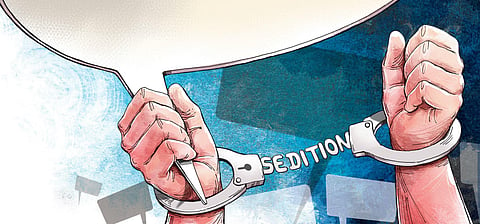

The trajectory of the cases in the Supreme Court challenging the sedition law (Section 124 A of the IPC) has been curious. The Centre initially opposed the prayer and said that the earlier Kedar Nath Singh judgment (1962), which endorsed the law, does not require any reconsideration. Thereafter, the government negated its own stand and said that at the behest of the Prime Minister, it wanted to revisit the law. The court agreed to the proposal and granted time to do this exercise.
Yet, when the petitioners pressed for staying the executive actions based on the provision, the government opposed it vehemently. According to the Centre, till the matter is reconsidered, it was enough to invoke the guidelines designed by the apex court in the Vinod Dua case (2021). The court, however, passed the historic order on May 11, practically suspending the invocation of the impugned provision. This was an unprecedented move after an unexpected turn of events.
Having found that the provision requires reconsideration, the Centre should have agreed to keep it in abeyance. Now, it is for Parliament to take steps to repeal the provision at the earliest. Anything short of that would shake the government’s credibility.
Misuse of a penal provision might not be a ground to annul it. For example, there could be a false charge of murder or rape in a case, which does not, however, mean that provisions relating to such heinous offences should be scrapped. Constitutionally, misuse cannot be a ground for the court to strike it down, as held in the Shreya Singhal case (2015).
The problem with Section 124 A is not just of its misuse. The text of the provision says that the words or signs which can lead to “hatred or contempt” or “disaffection” towards the government will be punishable as seditious. The explanation to the provision says that “disloyalty and all feelings of enmity” will amount to disaffection. The further explanations to the provision do not erase its inherent rudeness. The maximum punishment can be up to life imprisonment, with or without fine.
The question is simple. In a democracy could it be an offence to create disaffection towards the government? In every election, is it not the task of the opposition to criticise the government for its commissions and omissions to persuade the electorate to develop a strong dislike towards the existing dispensation?
In any fair system of governance, criticism of the government must happen freely, fearlessly, and continuously. During the colonial regime, Mahatma Gandhi was tried for sedition in 1922. Gandhiji explained that he was charged because as per the section, “promotion of disaffection is a crime”. Thereupon, Gandhiji said that it would be “a virtue to be disaffected towards a government which in its totality has done more harm to India than any previous system” and in such a scenario, according to Mahatma, it would be “a sin to have affection for the system”. In the Great Trial, Gandhiji was convicted and sentenced along with his associate Shankarlal Banker, the co-accused, and was taken to Sabarmati jail.
In the Kedar Nath Singh case, the Supreme Court validated the provision by saying that the offence will be made out only if the act involves an incitement to violence. But then, the provision did not even indicate so. The executive always used the provision as it stood in the Penal Code, and not as interpreted in the Kedar Nath Singh case. Thus, by sheer and indiscriminate use of the law as it occurs in the Code, the use of the law itself becomes an abuse. What makes the provision bad is its monstrous declaration that anything against the “government established by law” can be termed as an offence leading to even life-long incarceration. It is the overbreadth of the provision that ‘traps the innocent’ and subverts individual autonomy and free speech that erases its legitimacy. Sedition, according to the Code, is a cognisable offence where one can be arrested even without a warrant.
In the Kedar Nath Singh case, the court presumed the constitutionality of the provision and interpreted it with certain qualifying words and said that even strong words without incitement to violence will not amount to the offence. But the presumption of constitutionality is a claim that only the post-constitutional laws can stake, for those have the deliberative legitimacy of being passed by the elected lawmakers. This cardinal rule was ignored in the case. More significantly, the verdict failed to note the judgment of the Constitution bench in the 1960 Ram Manohar Lohia case which said that only if there was a serious threat to public order, the freedom of speech could be restricted under Article 19 (2) of the Constitution.
As famously described by Gandhiji, sedition law is essentially political. After Independence, the provision was invoked by different regimes to suppress the dissent and intimidate the potential critics. The point is whether there will be executive and legislative introspection making a further judicial scrutiny unnecessary.
Let it be also very clear: Repeal of sedition law in itself may not guarantee the protection of citizen’s rights in India. There are other draconian statutes and provisions in the realm of penal laws which again may not stand the test of constitutionality. The Unlawful Activities (Prevention) Act (UAPA), the National Security Act (NSA) and the Public Safety Acts like the one in J&K need to be reviewed in terms of the emerging jurisprudence on human rights. The misuse of penal provisions as a whole needs to be checked. Not only the colonial baggage but also all the post-colonial baggage which do not fit the ideas of liberty and dignity are to be discarded.
Kaleeswaram Raj
Lawyer, Supreme Court
Email: kaleeswaramraj@gmail.com
Twitter: @KaleeswaramR